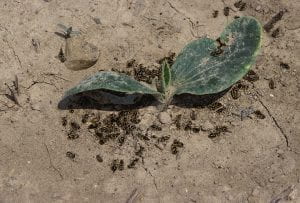Jim Jasinski (Extension), Ashley Leach (Entomology)
It’s been cool and wet in most of Ohio slowing most planting schedules but cucurbit planting is poised to hit it’s stride toward the end of May through mid-June. This means growers need to be on the lookout for the primary early season pest of pumpkin, squash, melons, cucumbers and zucchini, the striped cucumber beetle.

Striped cucumber beetle adult.
These adult beetles are overwintering now but will begin actively searching for cucurbit seedlings to feed on, sometimes inflicting severe enough damage to outright kill plants. Recall that while seedlings can survive and outgrow minor beetle damage, it is key to avoid severe damage to seedlings in order to prevent bacterial wilt transmission while the plants are most susceptible, typically prior to the 3-4 leaf stage. Bacterial wilt infected plants will become symptomatic once there is high demand to translocate water from the roots to the shoots, such as the time of fruit enlargement. No treatments are available to reduce bacterial wilt once a plant is infected.

Bacterial wilt infected plant in foreground, healthy plant in background.
Scouting newly emerged cucurbit plantings every few days is essential to determine if enough beetles or damage is occurring to warrant treatment. Action thresholds vary from 0.5 – 1 beetle per plant for cotyledon and 1st leaf stage seedlings to 1-2 beetles per plant for 3-4 leaf stage seedlings. Scout about 50 plants in both edge and interior areas throughout the field, flipping over leaves and especially looking under cotyledons to accurately determine beetle pressure and damage.

Severely damage cotyledon by striped cucumber beetle feeding.
Foliar insecticide recommendations for all cucurbit crops can be found in the Midwest Vegetable Production Guide (https://mwveguide.org/uploads/pdfs/Cucurbit-Crops.pdf).
To prepare for the arrival of striped cucumber beetles, consider reviewing a short but detailed video of several management options (beetles/plant thresholds, systemic seed treatment, use of transplants and in-furrow application) posted to the OSU IPM YouTube channel (https://youtu.be/RSzTT_gbma4).
A quick word about using insecticides to manage early season beetle populations. Based on your farm history with damage from this pest, field size, time of direct seeding or transplanting, you may not experience peak beetle pressure and can manage this pest by frequently scouting seedlings and treating if over threshold, the old fashioned IPM method!
If you purchased systemic insecticide coated seed (FarMore FI 400) which is very effective at controlling beetles, as evidenced by the pile of dead cucumber beetles on and near the treated plant, be aware that trace residues will accumulate in the pollen and nectar. If foraging honey bees, bumble bees, squash bees and other pollinators collect these food resources they may not be outright killed but more subtle sub-lethal effects on brood such as reduced feeding, fewer wax cells constructed, fewer eggs laid and other effects might occur. So, decisions about pesticide selection, pest severity, timing and non-target impacts should be considered before use.

Dead cucumber beetles at base of systemic insecticide treated plant. Courtesy of Celeste Welty.
If using FarMore FI 400 treated seed to raise transplants, do not treat them again with a systemic insecticide product during field setting as this will increase the residues found in pollen and nectar. If applying systemic products in-furrow, using the lowest labeled rate will still provide great beetle control for 2-3 weeks.